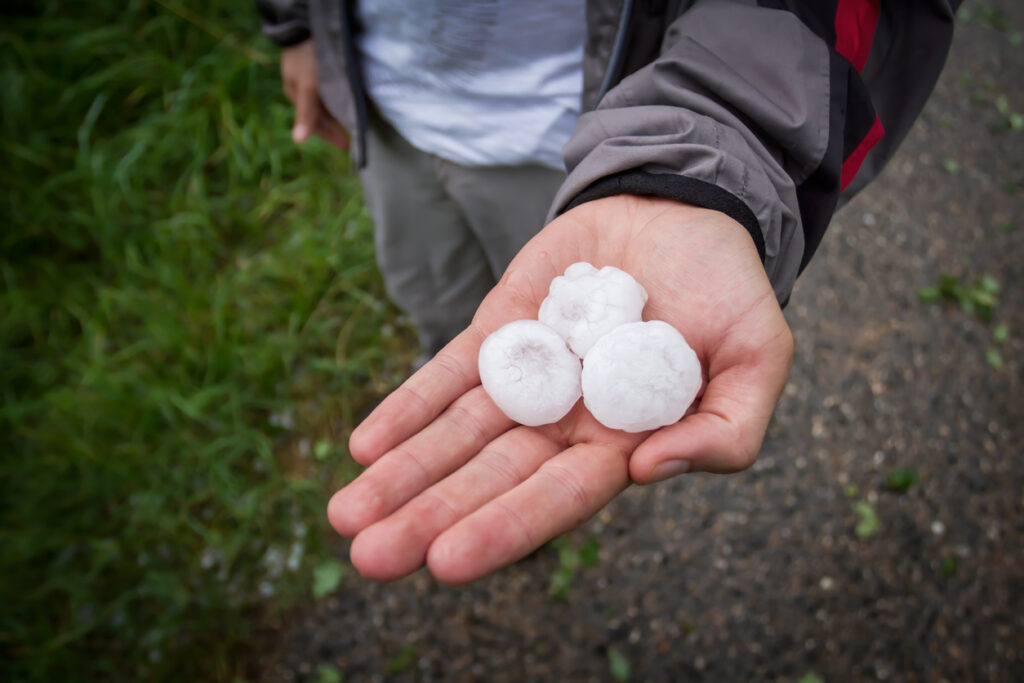Hail is one of nature’s strangest forms of weather. It blows in during unusual times of cold and mixed air. It forms when small ice particles are thrown back up into the freezing atmosphere again and again. Each time through, the hailstones get bigger by building on more ice until they are large enough to damage your home.
If your roof has been damaged by hailstones, you likely require roof repair on a number of shingles – and some hail damage can be so intensive that a roof replacement is required. But how do you know? The damage left by hailstones is often small and difficult to see initially. But the long-term problems of unattended hail damage to the roof can be serious.
For York, South Carolina homeowners who deal with unusual and intense weather on a regular basis, we’ve put together an easy guide to identifying hail damage to your roof after a hail storm.
1. Your Roof Develops “Hail Pox.”
What happens when hail hits your roof? Both asphalt and wood shingles will form “pock marks” or a pox appearance when looked at closely. Hail pummels the top of a roof with sharp hits from round and not-so-round ice balls that hit the roof from high altitudes, in high winds, and at very high speeds. Whether you are looking from a distance or up close, you may notice that your roof has developed a case of pox or a network of dark little hailstone marks where the hail has impacted and damaged individual shingles.
2. The Roof Has a Strangely Rough Texture from a Distance
What can you see of hail damage to the roof from a distance? Standing back from your home, you may notice that the roof has gained a certain rough-looking texture. This is because hail makes small, dark marks on the shingles that are slightly darker than the rest of the roof -though tiny. The tiny dots at a distance have the effect of light shading with pencil strokes. Though you can’t make out the individual hail marks, you can tell that something has disrupted the smooth material appearance of your roof.
3. Hail Dents in the Gutters and Down Spout
One way you can easily spot hail damage without checking the top of your roof is to look at the gutters and the downspout. These roof-adjacent features weather the same hailstorms as your rooftop but can be seen safely from the ground. If your gutters and downspout aluminum show signs of dented panels and small, hard impacts, this is hail damage that very likely also affects your roof.
In fact, often, the first sign and reminder to homeowners after a hail storm that there may be roof issues to discover and repair are dents in familiar and ground-level objects like the porch, downspout, and even knocked holes in the screen door. If you see these dents, it’s likely time for a roof inspection as well.
4. Roof Granules in the Gutter and Yard
Another thing that hail does is knock off granules. Typical roof shingles are made of asphalt composite layers, and the final layer is a coating of UV-resistant shingles. This is what gives roofs that granulated texture looks up close. Even very small hailstones can clock the granules off your roof shingles, reducing their RUV protective qualities and effectively shortening the lifespan.
After a hailstorm, you will typically see a lot more granules on the ground around your roof, or your gutters might fill with granules as they roll off the broken shingle surface.
5. Shingles Have Small Dark Spots and Indents
If you or an inspector get up on the roof to look closely at the shingles, you will notice that hail damage forms dark spots. The exact color will depend on the original color of your shingles. However, all asphalt composite shingles form dark spots where hail has hit. Look closer, and you will see that each one is an indent in the surface of the shingle. This indent is a tiny crater mark where the hailstone hit. Any shingle with multiple marks was hit by multiple hailstones about them.
6. Shingles Soft and Bruised on Inspection
If you reach out and touch one of the dark spots on a hail-damaged roof shingle, you will feel that it is softer than the shingle around it. This is why roofers tend to call hail-caused shingle damage a “bruise.” Where hail hits asphalt composite shingles that most phones have, it not only puts a dent in your roof shingles it also leaves a soft spot. A soft spot in the roof can quickly lead to leak risks unless faced with swift and timely repairs.
7. Cracked or Split Shingles
What happens when a large piece of hail hits a roof shingle near the center? In some cases, the shingle will actually split where the damage occurred, as if the hail had karate-chopped the shingle in half. When this happens, often, half of the shingle will be lost or damaged over the course of the last hail-carrying storm.
8. Hail Dents On Vent Covers and Chimney Covers
One of the worst side effects of hail damage to your roof is also hail damage to your roof fixtures. No one thinks of the roof vent cover until it’s sporting some truly impressive clusters of hail-caused dents. If you’ve got hail damage visibly on your vent covers, chimney cover, or even your flashing to things like the chimney, you likely also need hail roof repair as well.
9. Lifted or Missing Shingles and Exposed Mat
Finally, watch out for shingles that are in the process of peeling away from the roof surface. High winds and heavy impacts in a hail storm can result in completely missing sections or whole shingles. This is not only unattractive on your roof, but it’s also a very high risk for leaks during the next heavy rain. This is especially true if you can see the exposed mat beneath where the missing, split, or peeling shingles can be.

Roof Repair or Replacement after Hail Damage
Has Your York, SC home recently experienced a hailstorm? Can you see one or more of the signs that your roof has hail damage? We are here for you. Bee Roofing can help you inspect and identify hail-damaged shingles and help you understand if your roof needs repairs ore ven replacement as a result. Most hail damage can be repaired with a few, if widespread, shingle repairs. However, if the hail damage is heavy and extensive, and your roof is already near the end of its lifespan, you may want to consider roof replacement after hail damage instead.
To discover the full extent of your roof’s hail damage and to schedule the repairs or replacement of your York, SC home needs, contact us today!

